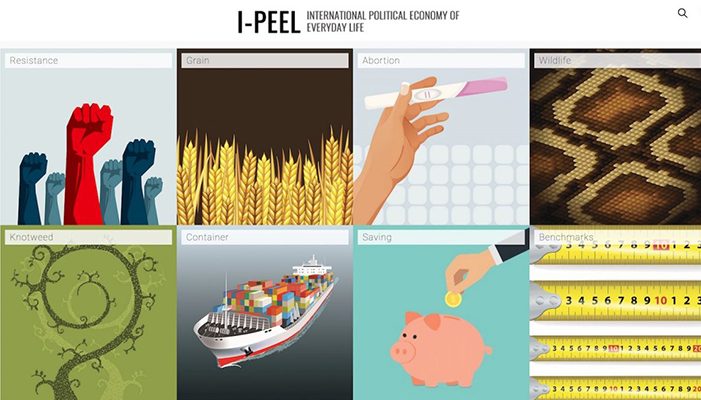
Who gets what in the global economy, why, and how might it be changed? These questions are of key concern to scholars in the field of International Political Economy (IPE). However, what makes IPE so insightful in addressing them also makes it pedagogically challenging. Concepts like financialisation, the developmental state, neo-imperialism and globalised social reproduction can easily appear distant to students. This distance is experienced both linguistically, in the use of novel terminology, as well as spatially, in the study of alien social and geographical worlds. No better example need be offered than the 2007 subprime mortgage crisis in the US, which called for a ready understanding of collateralised debt obligations and a subtle appreciation of the Wall Street-Treasury complex. Complex indeed.
Encountering these challenges in our own teaching when introducing students to core IPE issues, we found ourselves increasingly drawn to the familiar as a way of beginning conversation. Be it newspaper commentaries, clips from TV, or household products: the important thing was to provide a concrete platform for more abstract discussion, and in this way, also demonstrate the ways in which international economic processes happening ‘out there’ connected quite intimately with students’ own life experiences.
It was this approach that we took into the design of I-PEEL: International Political Economy of Everyday Life. Our idea was to develop an open-access website that used everyday objects and practices as entry points into the study of IPE, whereby users would ‘peel’ away an image to reveal a deeper analysis underneath.
To help with this we convened a board of advisors composed of undergraduate, postgraduate and doctoral students. One thing they immediately conveyed was the benefit of brevity. Short articles, in the region of 1,500 words, were preferred, with many mentioning the structure of Wikipedia entries as a format which allowed key points to be quickly distilled. Aesthetics were an important part of this too. The images we had used in our prototype grabbed their attention and gave the website an intuitive feel.
Another talking point was around the need to feature ‘trustworthy’ information from authoritative sources, whilst also demystifying disciplinary knowledge by revealing the active role played by academics in doing research. Students liked in particular the message that academics often took idiosyncratic approaches to their subject matter, and might disagree with one another in doing so, thereby inviting the student to make intellectual forays and challenges of their own.
What emerged from this input was a website that now features 29 entries on objects ranging from coffee to wildlife, and practices ranging from abortion to saving. Each is written by a different academic(s), drawing on their own research in that area and linking to wider debates. For instance, an entry on textbooks tells us how the teaching of comparative advantage routinely effaces the racial ‘unfreedoms’ within David Ricardo’s famous justification for free trade.
By committing to an online format, we were also able to embrace other pedagogical tools that elude the traditional hardcopy text. First, the website is structured in such a way that students are encouraged to navigate their own route through the subject material (‘I peel’). Whereas textbooks might impart a sense of priority to those topics covered first – with trade and finance almost always presented ahead of environment and development – the I-PEEL site randomly re-arranges the entry images every time the homepage is loaded, meaning that there is no ‘correct’ way of reading them. At the end of the entry, there is then a choice of three related entries to go and investigate further.
Second, the online format allows us to use images, audio clips, videos and even interactive features: the entry on ‘Housework’ has a calculator for valuing unpaid work, for instance. Appeal to the techniques of visual learning has the merit of engaging those students who might not be best served by textual and auditory learning (the standard fare of reading books and hearing lectures) whilst also communicating to the viewer a rich story given the 1,500 word limit. In the entry on Travel Guides, for example, what better way than the picture below to show how tourism reproduces stereotyped identities within ‘host’ communities?

Image: Ray_LAC (2011) ‘Kuhio Park hula dancer’, Honolulu, Hawaii, US
Our hope is that I-PEEL will be used to excite students about the prospect of studying IPE, and fit in alongside the use of established resources like textbooks and journal articles. To this end we have devised a teaching guide for I-PEEL, with suggestions to use it as part of a weekly set reading, a format for students to adopt and create their own IPE tile-style essay, or as the basis for a conceptual discussion around ‘the everyday’. We are also keen to carry on adding new entries to the site, especially from scholars writing from non-Eurocentric perspectives.
Further Reading on E-International Relations
- Student Essay Award – Win Free Books and Get Published
- International Political Economy
- Student Feature – Spotlight on the International Labour Organization
- Student Feature – Spotlight on Qualitative Methods in International Relations
- Student Feature – Advice on Using Theory in Academic Work
- Student Feature – Theory in Action: Poststructuralism and Media Representations of Terrorists